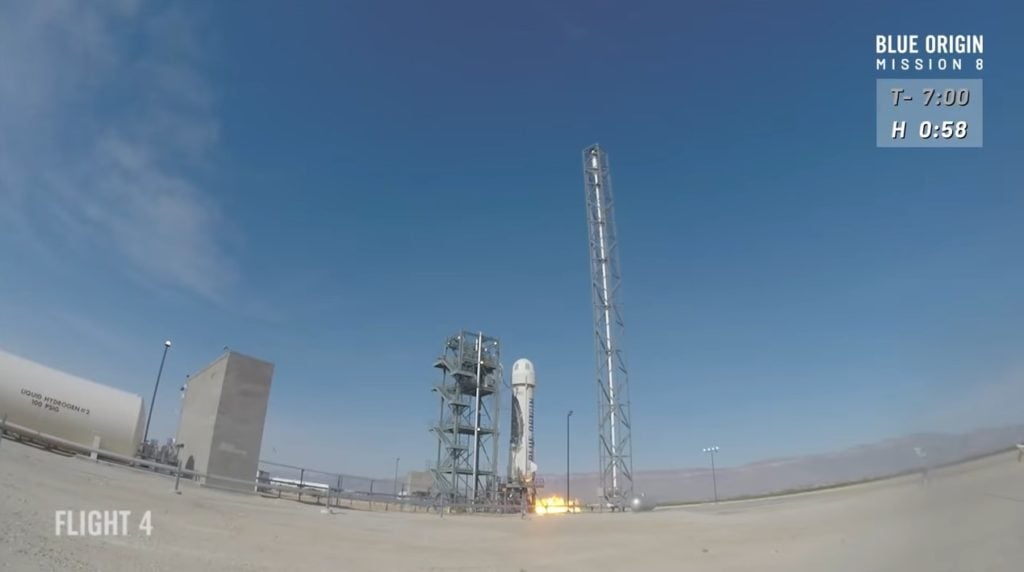Jeff Bezos’ space company, Blue Origin, has successfully completed the latest test flight of its fully reusable New Shepard launch system – bringing them one step closer to bringing private citizens into suborbital space.
The launch of the Blue Origin system – named New Shepard – took place from the company’s West Texas launch site at 1:06 pm EDT. The craft reached an altitude of 347485 feet, the highest flight it has reached to date – before returning back to Earth with a successful landing.
New Shepard is ordinarily designed to reach an altitude of 62 miles, and managed to surpass that goal by a decent margin by reaching a height of 66 miles – making it the highest distance it has managed to travel thus far, and blazing past the Kármán line—the widely accepted boundary between Earth’s atmosphere and outer space.
The rocket takes off and lands vertically by using boosters, just as we saw with SpaceX’s Falcon rockets, and this test flight was carrying a passenger capsule carrying a test dummy – known as Mannequin Skywalker. It was also carrying research payloads from NASA, the German Aerospace Center, and other commercial customers. This New Shepard launch is the most recent of private space launches that are starting to blur the lines between governmental agencies and businesses that have set their sights on space. While space travel was previously reserved for agencies like NASA, companies like SpaceX – and now Blue Origin – have proven that it’s possible to make space travel efficient and economical given enough resources and talent. The New Shepard launch brings Blue Origin one step closer to their goal of making space tourism a feasible option.
The capsule being carried by New Shepard managed to land successfully after detaching from the top of the rocket and deploying parachutes – making the eighth flight of the system since its first launch, back in 2015, a resounding success. This was the second test of the newly redesigned rocket and capsule – a redesign that has seemed to pay off.
Blue Origin has stated that they will likely not be taking passengers into outer space aboard the New Shepard until 2019, but they have already outlined what passengers who would like a trip into space have to look forward to.
When the spacecraft launches, passengers will experience two minutes of vertical ascent – after which the capsule, carrying up to six people at the time, will detach from the rocket and launch into outer space. At this point, passengers will experience weightlessness and will be able to see the curvature of the Earth through large windows – the largest windows of any spacecraft to date, in fact. After about four minutes in outer space, the New Shepard capsule will re-enter Earth and descend to the surface before landing – a process that is entirely automated. In addition to turning a profit through space tourism, New Shepard will also be available for hire by governments and private businesses in order to carry out experiments.
As mentioned above, the most recent launch carried experiments from a number of different agencies – allowing the test flight to play double duty by delivering equipment that can investigate the effects of microgravity on gene expression and test the ability to provide commercial WiFi access to users in space.
Jeff Bezos founded Blue Origin back in 2000 with the goal of bringing humanity into outer space while continuing to drive down prices. Only in the past few years has space travel started to become somewhat economical, and we’re a long way off from the average person being able to take a trip into space, but companies like Blue Origin and SpaceX are proving that the dream of expanding outside of the reaches of our own planet may be a real possibility. In addition to the New Shepard launch, Blue Origin is also working on a heavy-lift orbital rocket known as New Glenn – a project which is set to launch in 2020.
While 2019 and 2020 may seem a decent way off at this point, it’s actually quite a short time in terms of space travel. With SpaceX planning to send a man to Mars within the next couple of years as well, we could see our understanding of and reach into the rest of our universe expand quite drastically within just a few years. Hopefully the Blue Origin mission goes off without a hitch, allowing those with the resources to experience the magic of weightlessness and a view of our planet that precious few will be able to see.












